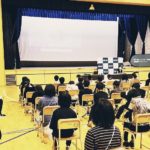VII Expansion of Support
1 Construction in Ushita
In 1952, housing construction had started in Ushita. In Hiroshima City, land prices surged compared to those of the past. They purchased land in Ushita at the price of 275,000 yen (about 750 dollars). This price was four times as expensive as the land price of Eba per 1 tsubo (3.3 m²). Schmoe came to Japan again and volunteers from Japan, (from Tokyo, as well as local students from Hiroshima and daily volunteers) also joined.
In 1952, a two-story house was built. It was a flat for four families and each room had one six-tatami mat room, kitchen and lavatory. The bathroom was shared. It was equipped with a garden for growing vegetables and fruit. In 1953, a guesthouse was constructed next to the flat. At first, it was assumed that this guesthouse would be used by international travelers. By staying at the guesthouse, volunteers from abroad would be able to come to Japan with their family and stay in the city for a long period. It was also expected that these volunteers could nurture mutual understanding and goodwill through interaction with Japanese families. Needless to say, tourists were able to use the guesthouse84.Since its location was some distance from the plumbing installed by Hiroshima City, the guesthouse was equipped with a water supply facility whose cost was covered by the budget of the Houses for Hiroshima project85.
2 Project in Nagasaki
The Houses for Hiroshima project was also conducted in Nagasaki, another city which had endured atomic bombing. In Nagasaki, housing construction started in the west side of Yamazato Elementary School in 1950. In that year, five Japanese-style houses with three rooms were built at the cost of 130,000 yen86. Also, there was a plan to establish a community like the one in Eba Village in Hiroshima. In a layout plan in a report, it was planned that a community house and a garden would be built in the center, with houses to be built around them. The community house in Nagasaki was built in 1951, when the community house in Hiroshima was established. The photos taken in that year show that the community center was placed in the highest place as designed in the layout plan. It had a second floor. Jim Wilson, a leader of the volunteer group in Nagasaki, took the initiative to build the community house with support from Audusson, Walkinshaw and Japanese volunteers who finished the project in Hiroshima. In Nagasaki, local carpenters also helped with the construction. Through 1950 to 1952, eight houses and one community house were reportedly built in Nagasaki87. Currently, those houses do not remain in the city. Schmoe Residence, the name of the municipal dwelling built in the place where the houses used to be, indicates the history.
84 Floyd Schmoe“HOUSES FOR HIROSHIMA PROGRESS REPORT NOVEMBER 1952” Floyd W. Schmoe Papers, 1903-1993 University of Washington Libraries, Special Collections Accession No.0496-008 Box12 Folder 16
85 Letter from Shinzo Hamai Mayor, Hiroshima City to Floyd Schmoe February 26, 1953 Floyd W. Schmoe Papers, 1903-1993 University of Washington Libraries, Special Collections Accession No.0496-008 Box12 Folder 4
86 Floyd Schmoe “HOUSES FOR HIROSHIMA Terminal Report 1950” Floyd W. Schmoe Papers, 1903-1993 University of Washington Libraries, Special Collections Accession No.0496-008 Box12 Folder 16
87 Floyd Schmoe“HOUSES FOR HIROSHIMA PROGRESS REPORT NOVEMBER 1952” Floyd W. Schmoe Papers, 1903-1993 University of Washington Libraries, Special Collections Accession No.0496-008 Box12 Folder 16





